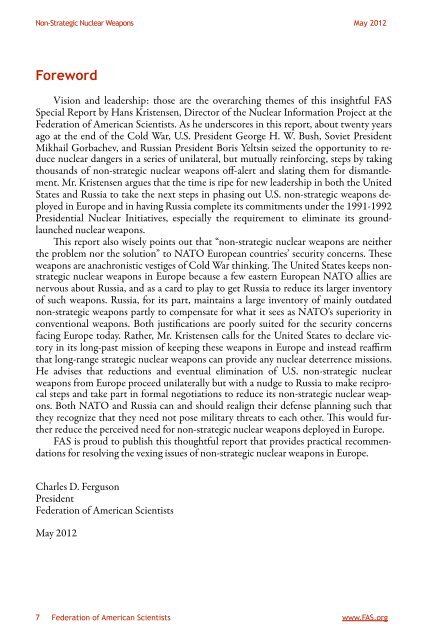Non Strategic Nuclear Weapons - Federation of American Scientists
Non Strategic Nuclear Weapons - Federation of American Scientists
Non Strategic Nuclear Weapons - Federation of American Scientists
Create successful ePaper yourself
Turn your PDF publications into a flip-book with our unique Google optimized e-Paper software.
<strong>Non</strong>-<strong>Strategic</strong> <strong>Nuclear</strong> <strong>Weapons</strong> May 2012<br />
Foreword<br />
Vision and leadership: those are the overarching themes <strong>of</strong> this insightful FAS<br />
Special Report by Hans Kristensen, Director <strong>of</strong> the <strong>Nuclear</strong> Information Project at the<br />
<strong>Federation</strong> <strong>of</strong> <strong>American</strong> <strong>Scientists</strong>. As he underscores in this report, about twenty years<br />
ago at the end <strong>of</strong> the Cold War, U.S. President George H. W. Bush, Soviet President<br />
Mikhail Gorbachev, and Russian President Boris Yeltsin seized the opportunity to reduce<br />
nuclear dangers in a series <strong>of</strong> unilateral, but mutually reinforcing, steps by taking<br />
thousands <strong>of</strong> non-strategic nuclear weapons <strong>of</strong>f-alert and slating them for dismantlement.<br />
Mr. Kristensen argues that the time is ripe for new leadership in both the United<br />
States and Russia to take the next steps in phasing out U.S. non-strategic weapons deployed<br />
in Europe and in having Russia complete its commitments under the 1991-1992<br />
Presidential <strong>Nuclear</strong> Initiatives, especially the requirement to eliminate its groundlaunched<br />
nuclear weapons.<br />
�is report also wisely points out that “non-strategic nuclear weapons are neither<br />
the problem nor the solution” to NATO European countries’ security concerns. �ese<br />
weapons are anachronistic vestiges <strong>of</strong> Cold War thinking. �e United States keeps nonstrategic<br />
nuclear weapons in Europe because a few eastern European NATO allies are<br />
nervous about Russia, and as a card to play to get Russia to reduce its larger inventory<br />
<strong>of</strong> such weapons. Russia, for its part, maintains a large inventory <strong>of</strong> mainly outdated<br />
non-strategic weapons partly to compensate for what it sees as NATO's superiority in<br />
conventional weapons. Both justifications are poorly suited for the security concerns<br />
facing Europe today. Rather, Mr. Kristensen calls for the United States to declare victory<br />
in its long-past mission <strong>of</strong> keeping these weapons in Europe and instead reaffirm<br />
that long-range strategic nuclear weapons can provide any nuclear deterrence missions.<br />
He advises that reductions and eventual elimination <strong>of</strong> U.S. non-strategic nuclear<br />
weapons from Europe proceed unilaterally but with a nudge to Russia to make reciprocal<br />
steps and take part in formal negotiations to reduce its non-strategic nuclear weapons.<br />
Both NATO and Russia can and should realign their defense planning such that<br />
they recognize that they need not pose military threats to each other. �is would further<br />
reduce the perceived need for non-strategic nuclear weapons deployed in Europe.<br />
FAS is proud to publish this thoughtful report that provides practical recommendations<br />
for resolving the vexing issues <strong>of</strong> non-strategic nuclear weapons in Europe.<br />
Charles D. Ferguson<br />
President<br />
<strong>Federation</strong> <strong>of</strong> <strong>American</strong> <strong>Scientists</strong><br />
May 2012<br />
7 <strong>Federation</strong> <strong>of</strong> <strong>American</strong> <strong>Scientists</strong> www.FAS.org
















